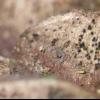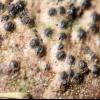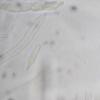
18-11-2025 13:59
Nogueira HéctorNovember 14, 2025 Brazuelo (León) SPAIN Hymenosc

17-11-2025 19:14
herman lambertApothécie discoïde 0.6 cm diam., orangeFace hym�

17-11-2025 21:57
Philippe PELLICIERBonjour,Récolté sur bois de feuillu mort dur, no

16-11-2025 21:09
 Robin Isaksson
Robin Isaksson
Anyone recognize this acc. to pictures.? Found on

17-11-2025 21:46
Philippe PELLICIERBonjour,Récolté sur bois pourrissant de feuillu

14-11-2025 16:26
 Marian Jagers
Marian Jagers
Hello everyone, On dead wood of Cytisus scoparius

15-11-2025 23:22
Mario FilippaHello,this is what I think to be Hymenoscyphus mac

15-11-2025 20:25
 Riet van Oosten
Riet van Oosten
Hello, Found by Laurens van der Linde, Nov. 2025
I have black, immersed perithecia on the cone scales of Picea orientalis. Diameter is about 0.2-0.3 mm. There is an elongated crest-like ostiolum. Spores are 12-14 x 3-3.4, hyaline, two-celled with a constriction at the septum. It seems to fit quite good to Lophiotrema boreale Math. as seen in Holm&Holm 1988. The problem is, this species seems to live on salix wood, not on conifers.
I wonder whether someone has alternative ideas as to this species or knows that L. boreale is that plurivorous. Probably I'm completely wrong.
Thanks in advance for any suggestions
Stefan
Have you observed ascospores in ink ? Perhaps, you could see gelatinous apical caps ? I have already found several times L. fuckelii on cones. But spores are longer.
If not, L. boreale would be the better solution.
Alain
Thanks a lot for the fast response. I can try ink tomorrow. But I don't think there are caps.
Stefan
Stefan
Hi Alain
Yes, I think I will name it L. boreale as long as there is no further knowledge. L. fuckelii also seems to be very plurivorous, isn't it?
Thanks
Stefan
Alain
Sehr schön. Vielen Dank!
Lieber Gruss
Stefan

In 2018 , GEIR MATHIASSEN & al. described a new species : L. borealiforme, rather close to L. boreale but with no spore guttulation.
It also says that many collections were erroneously identified as L. boreale instead of boleariforme.
I lately found on a Pinus sylvestris cone a collection with clearly guttulated spores which could actually be L. boreale. , with spores maxi 16 x 6µm
And the collection presented here by Stefan could be L. borealiforme.
AmitiésMichel
as said Björn,
Hi Stefan,
there IS further knowledge ;)
Merci Michel pour cet updating.
Pour ton Lophiotrema, la forme des ascomes et particulièrement la zone ostiolaire m'a fait penser au Mytilinidion byssisedum de Crouan fort heureusement recombiné en Lophiotrema byssisedum par Chenantais.
Je te join s la publi. Tu verras que beaucoup de caractères convergent. Mais qu'il en manque un, tu ne vas pas y échapper : la mise en évidence d'une enveloppe à l'encre, un réflexe dans cette famille.
Amuse toi bien, pour une fois que tu as un bel ascomycète sous les mains :)
Alain

Dans les papiers de Holm & Holm, et de Mathiassen, Crouan et Chenantais sont ignorés.
J'avais juste vérifié l'absence d'appendices dans le Bleu coton mais pas du halo autour des spores.
Comme il n y avait que 3 prithèces apparemment vivants, (esthétiquement massacrées pour la microscopie ) il va me falloir le retrouver , ce qui n'est pas si simple.
Il faudrait donc l'appeler L. byssisedum , c'est ça ? Amitiés
Michel
Tu connais la chanson... rentre le prudemment en L. cf byssisedum. Car je ne t'ai lancé qu'une idée (pas mal c'est vrai) , sans avoir vu la bête est son enveloppe sporale gélatineuse. Observer cette dernière permettrait d'avoir une bonne conviction.
Alain






 CHENANTAIS-J.-E.-1918-Etude-sur-les-pyrenomycetes-Lophiotrema-byssisedum-Bull.-Soc.-Mycol-.-France-Tome-34-p.134-136-0001.pdf
CHENANTAIS-J.-E.-1918-Etude-sur-les-pyrenomycetes-Lophiotrema-byssisedum-Bull.-Soc.-Mycol-.-France-Tome-34-p.134-136-0001.pdf